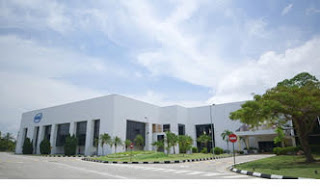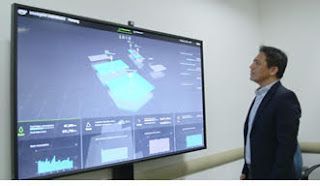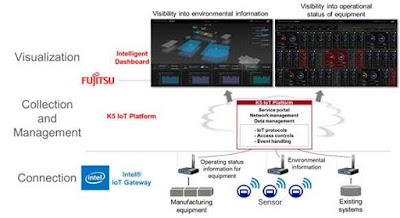Fujitsu Begins
Collaborative Verification of IoT-Based Visualization System in Intel’s Penang
Factory
Collaborative Verification of IoT-Based Visualization System in Intel’s Penang
Factory
Fujitsu Limited
Tokyo, April 27, 2017
Fujitsu announces to begin
verification of IoT-based visualization system in Intel Corporation’s
semiconductor factory in Penang, Malaysia, Intel’s largest factory outside the
U.S. The system can visually capture the operational status of its
semiconductor production lines and environmental data such as power and water
usage. This system links the FUJITSU Business Application Intelligent
Dashboard, an analysis and visualization tool that supports factory-wide
optimization, with the Intel® based IoT Gateway and the FUJITSU Cloud Service
K5 IoT Platform, a cloud-based IoT data utilization platform service.
verification of IoT-based visualization system in Intel Corporation’s
semiconductor factory in Penang, Malaysia, Intel’s largest factory outside the
U.S. The system can visually capture the operational status of its
semiconductor production lines and environmental data such as power and water
usage. This system links the FUJITSU Business Application Intelligent
Dashboard, an analysis and visualization tool that supports factory-wide
optimization, with the Intel® based IoT Gateway and the FUJITSU Cloud Service
K5 IoT Platform, a cloud-based IoT data utilization platform service.
This system offers
management a timely grasp on the overall situation in the factory, enabling
rapid tuning on policies and processes aimed to further enhancing productivity
and efficiency.
management a timely grasp on the overall situation in the factory, enabling
rapid tuning on policies and processes aimed to further enhancing productivity
and efficiency.
Beginning in May 2017,
Fujitsu will begin to offer this factory optimization solution, with a goal of
10 billion yen in revenue over the next three years.
Fujitsu will begin to offer this factory optimization solution, with a goal of
10 billion yen in revenue over the next three years.
Background
In May 2015, Fujitsu and
Intel began to collaborate on building IoT solutions. As the first phase , the
two companies launched a field trial with Shimane Fujitsu Limited, aimed at
increasing efficiency by providing visibility into the manufacturing process in
its factory, which produced results such as cutting shipping costs by 30%.
Intel began to collaborate on building IoT solutions. As the first phase , the
two companies launched a field trial with Shimane Fujitsu Limited, aimed at
increasing efficiency by providing visibility into the manufacturing process in
its factory, which produced results such as cutting shipping costs by 30%.
Intel’s Penang factory
Now,
as part of the second phase, Fujitsu begins verification of a system in Intel’s
Penang factory using IoT to provide visibility into the factory’s overall
status, including the operational status of semiconductor production lines and
energy usage. This marks the beginning of an initiative leading to improvements
in productivity and efficiency.
as part of the second phase, Fujitsu begins verification of a system in Intel’s
Penang factory using IoT to provide visibility into the factory’s overall
status, including the operational status of semiconductor production lines and
energy usage. This marks the beginning of an initiative leading to improvements
in productivity and efficiency.
Overview of the System
The system uses the
Intel® based IoT Gateway, from a lineup of gateway equipment for IoT systems,
to collect a variety of environmental data from electricity and water meters,
as well as from environmental sensors that measure temperature and humidity.
This is in addition to operational status data from the semiconductor
production lines, which is then centralized and managed in the K5 IoT Platform
service, a platform for IoT data utilization. Based on this collected data, the
system then visualizes important management indicators, such as the energy used
and related costs, and the capacity utilization of manufacturing equipment
through the Intelligent Dashboard, which provides a cohesive data display.
Intel® based IoT Gateway, from a lineup of gateway equipment for IoT systems,
to collect a variety of environmental data from electricity and water meters,
as well as from environmental sensors that measure temperature and humidity.
This is in addition to operational status data from the semiconductor
production lines, which is then centralized and managed in the K5 IoT Platform
service, a platform for IoT data utilization. Based on this collected data, the
system then visualizes important management indicators, such as the energy used
and related costs, and the capacity utilization of manufacturing equipment
through the Intelligent Dashboard, which provides a cohesive data display.
Effects of Environmental
Data Visualization
Data Visualization
Previously, at the Penang
factory, environmental data inside the factory was collected monthly. However,
management could not get a timely grasp on that data, which led to challenges
in applying data to enhance factory-wide efficiency.
factory, environmental data inside the factory was collected monthly. However,
management could not get a timely grasp on that data, which led to challenges
in applying data to enhance factory-wide efficiency.
By implementing this
system, data such as energy usage can be checked daily, enabling the
implementation of timely policies to improve factory operations.
system, data such as energy usage can be checked daily, enabling the
implementation of timely policies to improve factory operations.
IoT-based visualization system
Effects
of Visualization of Semiconductor Manufacturing Lines
of Visualization of Semiconductor Manufacturing Lines
Previously, operational
data for each piece of manufacturing equipment in the semiconductor production
lines was collected, aggregated and used on a case-by-case basis, such as in
determining the cause of problems with manufacturing equipment. However,
because management could not check the operational status of the production
lines in real time, there were difficulties in connecting that data to
improvements in productivity and efficiency.
data for each piece of manufacturing equipment in the semiconductor production
lines was collected, aggregated and used on a case-by-case basis, such as in
determining the cause of problems with manufacturing equipment. However,
because management could not check the operational status of the production
lines in real time, there were difficulties in connecting that data to
improvements in productivity and efficiency.
Implementing this system
enables a real-time view of the operational status of equipment throughout the
factory, helping management to rapidly implement countermeasures in production
lines facing problems.
enables a real-time view of the operational status of equipment throughout the
factory, helping management to rapidly implement countermeasures in production
lines facing problems.
Future
Developments
Developments
Based on the knowledge
and experience gained through both the field trial at Shimane Fujitsu and this
production efficiency visualization system at Intel’s Penang factory, Fujitsu
will begin offering this solution for optimizing entire factories using IoT to
customers in the manufacturing field in May 2017, with a goal of 10 billion yen
in revenue over the next three years. In addition, the two companies also aim
to expand into IoT solutions for other fields, such as distribution and retail,
as well as for the public sector.
and experience gained through both the field trial at Shimane Fujitsu and this
production efficiency visualization system at Intel’s Penang factory, Fujitsu
will begin offering this solution for optimizing entire factories using IoT to
customers in the manufacturing field in May 2017, with a goal of 10 billion yen
in revenue over the next three years. In addition, the two companies also aim
to expand into IoT solutions for other fields, such as distribution and retail,
as well as for the public sector.
Comment from Makiko Eda,
President, Intel K.K.
President, Intel K.K.
The joint demonstration
with Fujitsu on “Intelligent Dashboard” at Intel Penang Factory marks
our commitment in driving IoT innovations. By processing massive data generated
in a factory with Intel® based IoT Gateway and Intel® Xeon®-powered servers, we
will be able to visualize the factory in real-time and smart manner. Intel, in
collaboration with Fujitsu, will continue to advance the capabilities,
technology and the solution platform to enable the transformation of other
factories among the industries worldwide.
with Fujitsu on “Intelligent Dashboard” at Intel Penang Factory marks
our commitment in driving IoT innovations. By processing massive data generated
in a factory with Intel® based IoT Gateway and Intel® Xeon®-powered servers, we
will be able to visualize the factory in real-time and smart manner. Intel, in
collaboration with Fujitsu, will continue to advance the capabilities,
technology and the solution platform to enable the transformation of other
factories among the industries worldwide.
Related Websites
“Fujitsu and Intel Reach Agreement on
IoT Platform Collaboration,” press release, May 13, 2015
IoT Platform Collaboration,” press release, May 13, 2015
“Fujitsu Boosts Efficiency of
Manufacturing Processes at Shimane Fujitsu through IoT Collaboration with Intel,”
press release, May 19, 2016
Manufacturing Processes at Shimane Fujitsu through IoT Collaboration with Intel,”
press release, May 19, 2016
For the LATEST tech updates,
FOLLOW us on our Twitter
LIKE us on our FaceBook
SUBSCRIBE to us on our YouTube Channel!








